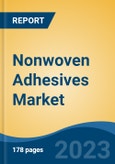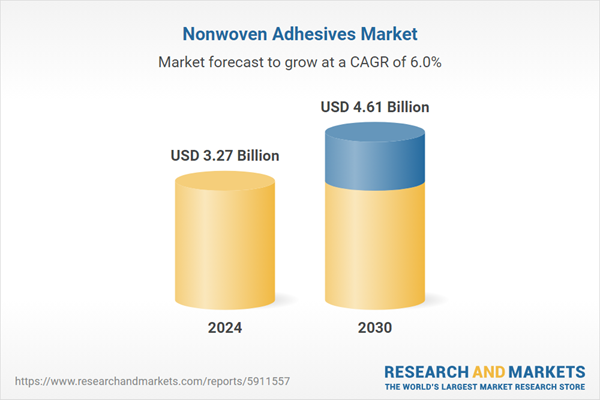Speak directly to the analyst to clarify any post sales queries you may have.
10% Free customizationThis report comes with 10% free customization, enabling you to add data that meets your specific business needs.
These adhesives play a critical role in bonding nonwoven materials, such as fabrics, tissues, and films, for the production of essential products including disposable diapers, adult incontinence products, feminine hygiene items, surgical drapes, and automotive interiors. Growing global emphasis on hygiene and cleanliness has significantly boosted the demand for disposable hygiene products, where nonwoven adhesives are vital to ensuring product integrity, comfort, and functionality. In the healthcare sector, the increasing adoption of nonwoven adhesives in wound dressings, surgical drapes, and other medical disposables aligns with advancements in medical technology and the rising need for high-performance healthcare solutions.
As environmental concerns intensify, the market is witnessing a notable shift toward sustainable and eco-friendly adhesive formulations. Manufacturers are proactively developing greener alternatives to address consumer expectations and meet evolving regulatory standards. However, achieving optimal adhesion across diverse nonwoven substrates remains a technical challenge, requiring customized adhesive formulations tailored to specific material characteristics. Regulatory compliance is also a key market consideration, particularly in hygiene and medical applications, where safety and quality standards are stringent. Ensuring adherence to these regulations is essential for market participation and long-term growth.
Key Market Drivers
Growing Demand for Disposable Hygiene Products is Major Factor for Nonwoven Adhesives Market Growth
The global nonwoven adhesives market is experiencing substantial growth, primarily driven by the growing demand for disposable hygiene products. Disposable hygiene products, including baby diapers, adult incontinence products, feminine hygiene products, and disposable medical products, have gained significant popularity worldwide. These products offer convenience, hygiene, and ease of use. According to the World Health Organization (WHO), unsafe drinking water, sanitation, and hygiene (WASH) were responsible for 395,000 deaths among children under five years of age.This stark figure underscores the critical importance of improving hygiene standards globally. As a result, there is growing demand for effective and reliable hygiene solutions, which directly impacts the nonwoven adhesives market. Nonwoven adhesives play a key role in manufacturing essential hygiene products such as diapers, wipes, and sanitary items. With increasing awareness of health and sanitation, particularly in developing and underdeveloped regions, the market is expected to witness accelerated growth in the demand for advanced, skin-friendly, and high-performance nonwoven adhesive technologies.
Nonwoven adhesives are integral components of disposable hygiene products. They are used to bond different layers of nonwoven fabrics, elastics, and absorbent materials, ensuring the structural integrity and functionality of these products. Effective adhesion is crucial in disposable hygiene products to prevent leakage, maintain comfort, and ensure product performance. Consumers expect secure and durable bonding in these products. Nonwoven adhesives come in various formulations, including hot melt and pressure-sensitive adhesives. They are versatile and compatible with different types of nonwoven materials, offering flexibility in product design.
Ongoing research and development efforts in the nonwoven adhesive industry have led to advanced formulations with improved adhesion properties, breathability, and softness. These advancements contribute to product quality and user comfort. The growing demand for disposable hygiene products is driving the need for specialized nonwoven adhesives. Manufacturers of disposable hygiene products seek adhesives that can meet specific performance requirements, such as absorbency, flexibility, and skin-friendliness. Disposable hygiene products offer convenience and hygienic solutions for consumers. They are preferred in various age groups and demographics, including babies, adults, and healthcare facilities. While disposable hygiene products provide convenience, there is a growing awareness of their environmental impact. This has led to developments in eco-friendly and biodegradable disposable products and adhesives.
The global nonwoven adhesives market is experiencing robust growth, primarily propelled by the growing demand for disposable hygiene products. Nonwoven adhesives have become indispensable in ensuring the reliable adhesion and functionality of these products, contributing to user comfort and hygiene. As the popularity of disposable hygiene products continues to rise, the market for nonwoven adhesives is expected to thrive. Manufacturers and suppliers in this market must remain at the forefront of technology and innovation to meet the evolving demands of product manufacturers, ensuring continued growth and improved hygiene outcomes worldwide, while addressing sustainability concerns.
Key Market Challenges
Rising Raw Material Costs
Rising raw material costs represent a significant impediment to the growth of the global Nonwoven Adhesives market. Nonwoven adhesives are indispensable in various industries, including hygiene products like diapers and feminine care, medical supplies, and automotive interiors, due to their role in bonding nonwoven materials efficiently. However, these adhesives rely on raw materials like polymers, resins, and chemicals, which are subject to price fluctuations driven by factors such as supply chain disruptions and market dynamics.The increasing costs of these essential ingredients can lead to elevated production expenses, ultimately impacting the prices of nonwoven adhesives. In a competitive market, price hikes can deter manufacturers and end-users, limiting market growth potential. Furthermore, the uncertainty surrounding raw material costs can disrupt supply chains and strain inventory management.
To mitigate the impact of rising raw material costs and stimulate growth in the global Nonwoven Adhesives market, companies must explore strategies such as diversifying raw material sources, optimizing production processes for cost efficiency, and researching alternative materials. These measures can help maintain product affordability, ensure supply chain stability, and facilitate market expansion.
Key Market Trends
New Technologies for Developing Non-Woven Adhesives
The development of new technologies for creating non-woven adhesives is a pivotal trend shaping the global nonwoven adhesives market. Nonwoven adhesives play a critical role in various industries, including hygiene products, medical devices, and automotive applications, by providing bonding solutions for nonwoven materials like fabrics and films. Emerging technologies are revolutionizing the nonwoven adhesive manufacturing process, leading to improved product performance, efficiency, and sustainability. These innovations encompass advanced adhesive formulations, application methods, and equipment designed to meet the growing demand for nonwoven products in a wide range of applications.Innovations in nonwoven adhesive technologies are focused on enhancing bonding strength, flexibility, and sustainability. For example, hot melt adhesives with lower application temperatures reduce energy consumption and enhance the eco-friendliness of the production process. Additionally, developments in the use of bio-based or recyclable materials align with the global shift toward more sustainable and environmentally conscious practices.
As industries continue to seek nonwoven adhesive solutions that meet evolving consumer preferences and regulatory standards, companies investing in these new technologies are poised to drive growth and innovation in the global nonwoven adhesives market.
Key Market Players
- Henkel AG
- H.B. Fuller
- Bostik SA
- Beardow Adams Ltd.
- Adtek Malaysia Sdn. Bhd.
- Moresco Corporation
- Dow Chemical Company
- 3M Corporation
- Kraton Corporation
- Evonik Industries AG
Report Scope:
In this report, the Global Nonwoven Adhesives Market has been segmented into the following categories, in addition to the industry trends which have also been detailed below:Nonwoven Adhesives Market, By Type:
- Amorphous Poly Alpha Olefin
- Ethylene Vinyl Acetate
- Styrenic Block Copolymer
Nonwoven Adhesives Market, By Application:
- Adult Incontinence
- Baby Care
- Feminine Hygiene
- Medical
Nonwoven Adhesives Market, By Technology:
- Hot-Melt
- Water-Based
Nonwoven Adhesives Market, By Region:
- Asia-Pacific
- China
- India
- Japan
- Australia
- South Korea
- North America
- United States
- Canada
- Mexico
- Europe
- France
- United Kingdom
- Italy
- Germany
- Spain
- South America
- Brazil
- Argentina
- Colombia
- Middle East & Africa
- South Africa
- Saudi Arabia
- UAE
- Egypt
Competitive Landscape
Company Profiles: Detailed analysis of the major companies present in the Global Nonwoven Adhesives Market.Available Customizations:
With the given market data, the publisher offers customizations according to a company's specific needs. The following customization options are available for the report.Company Information
- Detailed analysis and profiling of additional market players (up to five).
This product will be delivered within 1-3 business days.
Table of Contents
Companies Mentioned
- Henkel AG
- H.B. Fuller
- Bostik SA
- Beardow Adams Ltd.
- Adtek Malaysia Sdn. Bhd.
- Moresco Corporation
- Dow Chemical Company
- 3M Corporation
- Kraton Corporation
- Evonik Industries AG
Table Information
| Report Attribute | Details |
|---|---|
| No. of Pages | 185 |
| Published | August 2025 |
| Forecast Period | 2024 - 2030 |
| Estimated Market Value ( USD | $ 3.27 Billion |
| Forecasted Market Value ( USD | $ 4.61 Billion |
| Compound Annual Growth Rate | 6.0% |
| Regions Covered | Global |
| No. of Companies Mentioned | 10 |









